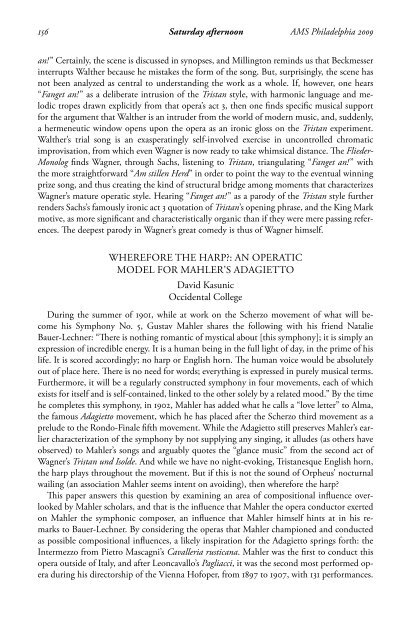AMS Philadelphia 2009 Abstracts - American Musicological Society
AMS Philadelphia 2009 Abstracts - American Musicological Society
AMS Philadelphia 2009 Abstracts - American Musicological Society
Create successful ePaper yourself
Turn your PDF publications into a flip-book with our unique Google optimized e-Paper software.
156 saturday afternoon <strong>AMS</strong> <strong>Philadelphia</strong> <strong>2009</strong><br />
an! ” Certainly, the scene is discussed in synopses, and Millington reminds us that Beckmesser<br />
interrupts Walther because he mistakes the form of the song. But, surprisingly, the scene has<br />
not been analyzed as central to understanding the work as a whole. If, however, one hears<br />
“Fanget an! ” as a deliberate intrusion of the tristan style, with harmonic language and melodic<br />
tropes drawn explicitly from that opera’s act 3, then one finds specific musical support<br />
for the argument that Walther is an intruder from the world of modern music, and, suddenly,<br />
a hermeneutic window opens upon the opera as an ironic gloss on the tristan experiment.<br />
Walther’s trial song is an exasperatingly self-involved exercise in uncontrolled chromatic<br />
improvisation, from which even Wagner is now ready to take whimsical distance. The Flieder-<br />
Monolog finds Wagner, through Sachs, listening to tristan, triangulating “Fanget an! ” with<br />
the more straightforward “Am stillen Herd” in order to point the way to the eventual winning<br />
prize song, and thus creating the kind of structural bridge among moments that characterizes<br />
Wagner’s mature operatic style. Hearing “Fanget an! ” as a parody of the tristan style further<br />
renders Sachs’s famously ironic act 3 quotation of tristan’s opening phrase, and the King Mark<br />
motive, as more significant and characteristically organic than if they were mere passing references.<br />
The deepest parody in Wagner’s great comedy is thus of Wagner himself.<br />
WHEREFORE THE HARP?: AN OPERATIC<br />
MODEL FOR MAHLER’S ADAGIETTO<br />
David Kasunic<br />
Occidental College<br />
During the summer of 1901, while at work on the Scherzo movement of what will become<br />
his Symphony No. 5, Gustav Mahler shares the following with his friend Natalie<br />
Bauer-Lechner: “There is nothing romantic of mystical about [this symphony]; it is simply an<br />
expression of incredible energy. It is a human being in the full light of day, in the prime of his<br />
life. It is scored accordingly; no harp or English horn. The human voice would be absolutely<br />
out of place here. There is no need for words; everything is expressed in purely musical terms.<br />
Furthermore, it will be a regularly constructed symphony in four movements, each of which<br />
exists for itself and is self-contained, linked to the other solely by a related mood.” By the time<br />
he completes this symphony, in 1902, Mahler has added what he calls a “love letter” to Alma,<br />
the famous Adagietto movement, which he has placed after the Scherzo third movement as a<br />
prelude to the Rondo-Finale fifth movement. While the Adagietto still preserves Mahler’s earlier<br />
characterization of the symphony by not supplying any singing, it alludes (as others have<br />
observed) to Mahler’s songs and arguably quotes the “glance music” from the second act of<br />
Wagner’s tristan und isolde. And while we have no night-evoking, Tristanesque English horn,<br />
the harp plays throughout the movement. But if this is not the sound of Orpheus’ nocturnal<br />
wailing (an association Mahler seems intent on avoiding), then wherefore the harp?<br />
This paper answers this question by examining an area of compositional influence overlooked<br />
by Mahler scholars, and that is the influence that Mahler the opera conductor exerted<br />
on Mahler the symphonic composer, an influence that Mahler himself hints at in his remarks<br />
to Bauer-Lechner. By considering the operas that Mahler championed and conducted<br />
as possible compositional influences, a likely inspiration for the Adagietto springs forth: the<br />
Intermezzo from Pietro Mascagni’s Cavalleria rusticana. Mahler was the first to conduct this<br />
opera outside of Italy, and after Leoncavallo’s Pagliacci, it was the second most performed opera<br />
during his directorship of the Vienna Hofoper, from 1897 to 1907, with 131 performances.










